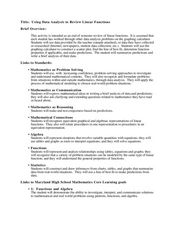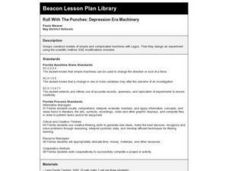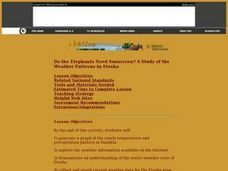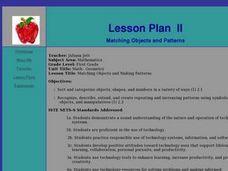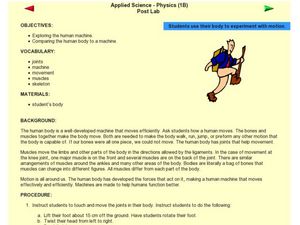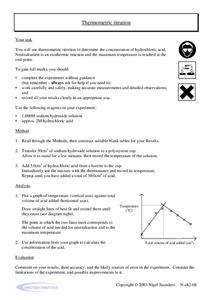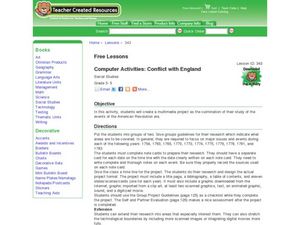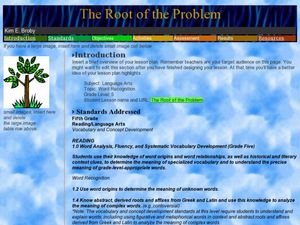Curated OER
Using Data Analysis to Review Linear Functions
Using either data provided or data that has been collected, young mathematicians graph linear functions to best fit their scatterplot. They also analyze their data and make predicitons based on the data. This lesson is intended as a...
Curated OER
Genetics the Easy Way
Learners use recyclable trash to construct a Recycle Critter family. They calculate the probability of the phenotype of the offspring that two heterozygous parents produced.
Curated OER
The Uncertain Future of Kosovo
Young scholars investigate the ongoing peace process in Kosovo through thorough discussion of the underlying issues of the Kosovo conflict and the evolving resolution.
Curated OER
Roll with the Punches: Depression Era Machinery
Students construct models of simple and complicated machines with Legos. Then they design an experiment using the scientific method. ESE modifications included.
Curated OER
Do the Elephants Need Sunscreen? A Study of the Weather Patterns in Etosha
Students analyze the weather patterns in Namibia. They create a graph of the yearly temperatures and use the internet to gather information. They discuss how the weather goes in cycles in the area.
Curated OER
Volume and Surface Area: Which Is More?
Learners explore the volume and surface area of three dimensional figures. Through the use of video, students discover three dimensional shapes, their uses in real-life applications, and methods used to calculate their volume and surface...
Curated OER
Matching Objects and Patterns
First graders participate in hands-on activities and use objects to create patterns. They observe a PowerPoint lesson describing matching objects and patterns. In groups, 1st graders complete geometry computer activities such as planting...
Curated OER
Understanding the Bohr Model
In this Bohr model worksheet, high schoolers read about Neils Bohr and the model he proposed of the atom. Students answer nine questions about his theory that electrons travel in orbitals and give off energy when they are excited.
Curated OER
Geometry of Triangles Using a Protractor
Seventh graders use a protractor to measure angles and solve a problem involving distance. For this measuring angles with a protractor lesson plan, 7th graders calculate the distance of a line on a diagram by using a protractor to...
Curated OER
Graphs
In this algebra worksheet, learners solve linear equations through graphing and quadratic equations through factoring. There are 4 questions dealing with systems of equations.
Curated OER
The Fact Finders
Students analyze agricultural data and make predictions about events in history. In this history lesson, students correlate the relationship between historic events and issues in agriculture to see if there is a correlation. They analyze...
Curated OER
Elbow Room - Exploring Population Density
In this population worksheet, students click on the links and research the internet about population, land, and government. Students answer 16 short answer questions including making spreadsheets.
Curated OER
Preparing for the Weather
Students discuss hypothermia and recognize how insulation helps keep people warm. In this science instructional activity, students get into four groups and go to each activity. Students simulate what it is like to stay warm using...
Curated OER
What's the Best Deal?
Students explore number sense by solving consumer math problems. In this pattern identification lesson, students analyze a list of numerical and geometric patterns while predicting the future outcome. Students utilize inference skills to...
Curated OER
Human Machine
Students explore the human body by conducting an exercise in class. In this human anatomy lesson, students view a diagram of the human body and identify the specific bones and joints that allow us to perform specific exercises like...
Curated OER
Exploring an Atlas
Students explore global geography by participating in an atlas activity. In this countries of the world lesson, students collaborate in small groups and analyze an atlas while researching continents, countries and demographics. Students...
Curated OER
The Moon's Density-What's Inside?
In this moon's density worksheet, students solve 4 problems about the Moon and a model planet. They find the Moon's density and they find its volume. They make a model of a planet's interior and use its mass and radius to find the...
Curated OER
Satellite Technology
In this satellite technology worksheet, students read about Low Earth Orbit satellites and the frictional drag from the Earth's atmosphere that causes them to fall back towards the Earth. Students use given data of the years the...
Creative Chemistry
Thermometric Titration
In this thermometric titration learning exercise, learners titrate hydrochloric acid with sodium hydroxide to determine its concentration. They measured the solution's change in temperature, plotted their data, and used the graph to find...
Curated OER
How Does Your Garden Grow?
Students examine birdseed to see if it is a fertilized seed. For this birdseed garden lesson, students experiment with birdseed on a sponge to see what grows. Students record the growth of seeds.
Curated OER
American Revolution Multimedia Project
Students create multimedia projects based on the American Revolution Era. In this American History lesson, students combine photographs, slides, and video to present the time line of the American Revolution to the rest of their class.
Curated OER
Food Pyramid Power: Looking Back and Moving Forward
Pupils show their knowledge of properties of objects as it pertains to sorting and creating patterns. In this food pyramid power lesson plan, students show their ability to use whole numbers in different representations by appling...
Curated OER
Patterns Here, There, and Everywhere!
Upper graders access the Microsoft Word program and create patterns by utilizing certain keys on the keyboard. They create picket fences, smiley faces, and hearts. It seems that this lesson has as much to do with keyboarding skills as it...
Curated OER
The Root of the Problem
Identifying root and base words is an important skill. Using this lesson, learners practice identifying Greek and Latin roots. However, this resource is incomplete and should be augmented to provide a complete experience.
